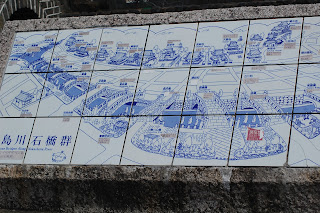[post of
Friday 17th of August 2012]
We’re only
few km away from the legendary city of Nagasaki.
When we get
up for breakfast, the sisters of the convent have prepared us not only the
typical Japanese breakfast but, worry about our way to travel, have filled up
our travel bottles with sport drinks instead of simple water. In addition, they
give us a couple of extra bottles of frozen Aquarius for later on, together
with a bag of biscuits and some fruit flavoured gelatines.
After cycling
up-hill through a road with difference in height of 200 metres, we run back
down-hill, into Japanese hillside, and we follow a snake-looking river up to
the very heart of Nagasaki. We get a bit lost once there, although it’s not too
difficult to find our way to the hotel; once there, we get rid of our backpacks
and our “working” outfits; we dress up in our “city” clothes and we head off to
discover Nagasaki on foot.
First stop,
Dejima Island. When Japan decided to shut down all entrance to the outer world,
in the middle of the 17th century, a tiny window was left open. That
is when Dejima, an artificial island, was built up to become a port for the Dutch
vessels which landed there, once a year, with all kind of goods and news, such
as artistic, medical, and scientific alike… and so Dejima remained up to the
moment in which Japan opened up again to the outer world, during the Meiji Era.
Second stop:
the bridges of Nagasaki. The river that runs through the city from North to
South is full of many bridges, the oldest one built in 1620. We went through as
many of them as we could. We crossed them back and forth, saw from them the
carps, huge as sharks, down in the river.
Third stop:
the street of the temples. Silently, with the head low, above all because of
the hundreds of steps up we have to go through, we get to see the different
temples built up parallel to the main river.
Final stop:
the museum of the 26 martyrs. This is where Ainhoa wanted to come. This is a
museum dedicated to the Christians who have suffered martyrdom in here. The first
martyrs were six Franciscans (a Mexican and five Spaniards), then there were 20
Japanese, some of them Jesuits, other their helpers. The museum’s walls are
full of objects and documents crucial to Ainhoa’s PhD dissertation, but
pictures are not allowed. Ainhoa even tries to explain the situation, and her
academic interest, to the staff in the ticket office. She asks if there is
anyone who speaks English there, but they answer negatively… how to do to communicate
with these people then? How to share the importance and the need of having
images from these artefacts? So she thinks to give it a try also with Spanish…
and then there is a reaction from the person at the office, who says a “chotto
matte” (“wait a minute”) and gets over the phone. On the other side of the line
there is someone, and she speaks perfect Castilian. Without even introducing himself,
he says to Ainhoa, “Riojana! [from
the Spanish region named “La Rioja”, where Ainhoa is from] How come you didn’t bring
some wine?” [La Rioja is known worldwide for its wine]
He’s Father
Aguilar, from Mexico, and he’s in charge of the Nagasaki church of the martyrs
from more than a half century. We tell him our story, talk to him of our
journey, and he’s instantly worry for us; in few minutes he comes back to us
with some orange juice, ice-cream and chocolate biscuits, which of course we
cannot but gladly accept. As we enjoy this surprise break, Father Aguilar keeps
talking: about Japanese topics, family, love, the bloody WWII and the nuclear
bomb that should never have been used. We spend the main part of the afternoon
listening to the incredible memories of WWII, the same that the direct
witnesses had told the Father years before. We are impressed to know that one
of his Jesuit brothers was a kamikaze in those years. We get carried away by his
kindness and conversation and, at the end, the museum is already closed… so
Father Aguilar calls Father Renzo to open the museum back just for us to see it
outside the opening time. This is our good-luck star watching over us that looks
after us all our life, the same that usually asks something in exchange too. During
the visit to the museum, Ainhoa lost one of her bike-gloves… although next day she
would find another one, same size than hers, on the road.
After the
museum, we had a walk around the city at night and, among modern neon lights
and traditional Japanese lanterns, we arrive to the Ebisu Youth Hostel, which
we think is too expensive for the level of facilities that it offers. In addition
to that, the woman who owns it has poorly furbished the upper floor, and we’re
not talking about the aesthetic of the architecture here; she even gets the
great idea of giving a glass of sake to all her customers, included some Koren
children. One of them drinks it all in one shot and starts coughing, until he
has to run to the resting room. The worst of all is that we have decided that,
regardless of our critics and doubts about the place, we would spend the night
at Ebisu Hostel to use the wi-fi connection, update the blog, send some emails
and messages to our families, and keep on planning the rest of the journey… but
the connection works only for a little bit and we manage to send only a short “message
of life” to our relatives! So goodnight for now and let’s hope tomorrow the
show would keep going on.













No comments:
Post a Comment